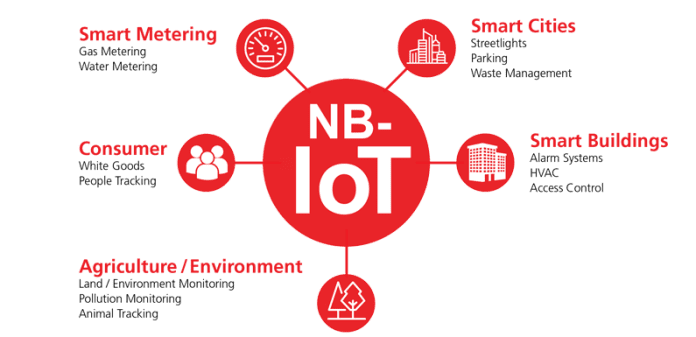In June 2016, 3GPP finalized its Release 13 LTE Advanced-Pro specification, which included the fundamental technological features of narrowband-internet of things (NB-IoT) connectivity. Since then, the connectivity scheme has gained widespread attention and adoption from the global operator communities in support of use cases that require minimal throughput and capacity, but rely on robust coverage and penetration.
Here’s a quick run-through of the key features of the NB-IoT spec: maximum downlink throughput of 50 Kbps; maximum uplink throughput of 50 Kbps for multi-tone, 20 Kbps for single-tone; coverage of 164 dBm for the standalone variant; and a 180 kilohertz channel width.
Simon Glassman, senior principal of strategic partnerships at u-blox, described NB-IoT as a solution for the IoT’s “last mile problem. While the cloud infrastructure to gather and analyze data is ready today, a robust wireless infrastructure with the range, low-power and low-cost characteristics to connect large numbers of devices to the internet hasn’t been ready – until recently. NB-IoT…is a new wireless standard built specifically with low-power, low-cost IoT devices in mind, designed to work with cellular network infrastructure. Rather than having to use proprietary gateways, device makers can concentrate on device functionality instead of worrying about wireless infrastructure.”
He identified key use cases as smart metering, precision agriculture, smart buildings and smart cities, among others. “Since the link budget of NB-IoT is concentrated over a narrow frequency band,” Glassman continued, “it’s able to achieve long-range communications with low power usage. In addition, the narrowband nature along with sub-gigahertz deployment means NB-IoT has excellent penetration. Since it uses licensed cellular spectrum, NB-IoT also has better signal integrity and less chance of interference than protocols that have to compete with Bluetooth, Wi-Fi and other protocols on the increasingly cluttered industrial, scientific and medical bands.”
NB-IoT for smart street lighting
Nordic telecom group Telia Company and Datek Light Control have developed a prototype for smart street lighting in Norway using narrowband-internet of things (NB-IoT) technology.
Telia said the new prototype simplifies the installation and control of smart street lighting resulting in a reduced energy consumption and an optimized system where lighting automatically adapts to the surroundings, and lamps report irregularities, provide alerts and maintenance scheduling, among other things.
When a light fixture is installed in a lamppost, it will automatically connect to Datek’s server via Telia’s network and report its GPS position to Datek’s map application.
“We see that NB-IoT is one of the technologies that can increase the penetration of intelligent guidance systems. In collaboration with Telia we have made a prototype that, in many cases, simplifies the installation of intelligent light fixtures, said Øyvind Sløgedal, CEO of Datek Light Control. “This is a real “plug and play” solution for intelligent outdoor lighting.”
Smart metering for utilities in the Middle East
Nokia and Middle East telecommunications operator Zain have announced the completion of a trial of NB-IoT technology at a live site in the Mina area of Makkah province, in Saudi Arabia.
In the trial–which used smart metering as a test use case–NB-IoT was applied to communicate temperature, humidity and air pressure from a remote location via a Nokia LTE base station at 900 MHz, demonstrating the role NB-IoT could play in applications such as smart metering for electricity departments, smart parking and smart waste management, the involved firms said. The NB-IoT trial follows the MoU signed by Nokia and Zain Saudi Arabia to collaborate on 5G and IoT development.
In the NB-IoT trial, data was transferred using Nokia’s LTE radio platform Flexi Multiradio 10 Base Station and Nokia’s professional services, including system integration, network implementation, and care services.
“This Saudi-first IoT trial in a live network again shows our strong commitment to bring new services to make people’s lives more comfortable and productive. It has been a fruitful, decade-long journey with our longtime partner Nokia in transforming telecom services in Saudi Arabia, and now this successful joint trial accelerates our initiatives in building smart cities across the Kingdom including Riyadh and Jeddah,” said Abdulaziz AlDeghaither, Chief Technology Officer at Zain Saudi Arabia.
End-to-end network comes to life in Hong Kong
With narrowband internet of things (NB-IoT) the connectivity of choice in China per government officials, mobile operator 3 Hong Kong and vendor Huawei have announced the completion of of an end-to-end network in Hong Kong. Additionally, 3 Hong Kong and the Hong Kong Science & Technology Parks Corporation are jointly working to develop NB-IoT applications for various industries and take them to market.
“Huawei is keen to enter an era that will see all things connected via the internet. We are therefore committed to raising industry standards, developing chips, building networks and cultivating business partners as part of an…industrial ecosystem,” Peter Zhou, chief marketing officer of Huawei’s wireless network product line, said.
3 Hong Kong is currently working with Hong Kong’s Power Assets Holdings Limited to research possibilities around NB-IoT applications. The work includes applying NB-IoT technology to water and electricity meters. Such applications are also being developed for surveillance and management of oil pipelines, while others involve big data analysis and smart surveillance to save energy and boost operational efficiency, the telco said.

